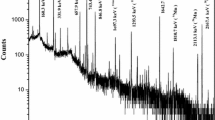Abstract
The measurement of impurities, specifically; the combination of magnesium, silicon and aluminum, in polymers and in mixed additives is a common problem for industrial application of neutron activation analysis (NAA). Typically this problem can be addressed using XRF and ICP. However, in some cases, the available sample size, desired detection limit and the desired accuracy prohibit the use of XRF or ICP. Therefore under these requirements, as in the measurement of talc in milligram size polymer fibers, using NAA has become a niche for nuclear analytical applications. Other important advantages, apart from high precision and lower detection limit, are the non-destructive nature of the analysis and the minimal sample preparation necessary to carry out the measurement. Therefore, polymers such as polyethylene, polystyrene or poly-carbonate can be analyzed for these metals as organic solutions, beads, films, pellets or powders. This paper highlights some of the recent improvements made to the Dow NAA measurement facility to accomplish this task.

Similar content being viewed by others
References
Yusuf S et al (2000) Industrial material characterization using neutron activation techniques. ANS Trans 82(88):1–300
Yusuf S (2003) Improving the detection limit of fluorine in polymers by neutron activation analysis using a TRIGA® nuclear reactor. ANS Trans 89:683–685
Ismail S et al (2001) Dynamic irradiation counting systems for fast, short-time activation analysis using a fully automatic movable counting chamber and a digital spectrometer. Instrum Sci Technol 29(4):255
Yusuf S (1993) Shape-Independent model of monitor neutron activation analysis. PhD thesis, The University of Michigan
Gedcke D (2001) How counting statistics control detection limits and peak precision. ORTECTM Application Note, AN59
Acknowledgement
The author will like to acknowledge Dr. Melinda Krahenbuhl and Mr. Bryan Haskins for their support of this work.
Author information
Authors and Affiliations
Corresponding author
Additional information
TRIGA® is a registered trade mark of the General Atomics company. CANBERRA™ is a trade mark of the Canberra Industries, Inc. Ortec™ is a trade mark of the Advanced Measurement Technology, Inc.
Rights and permissions
About this article
Cite this article
Yusuf, S. Improving the detection limit of silicon, magnesium and aluminum in neutron activation analysis of polymers using a TRIGA® reactor. J Radioanal Nucl Chem 282, 99–104 (2009). https://doi.org/10.1007/s10967-009-0212-6
Received:
Accepted:
Published:
Issue Date:
DOI: https://doi.org/10.1007/s10967-009-0212-6



